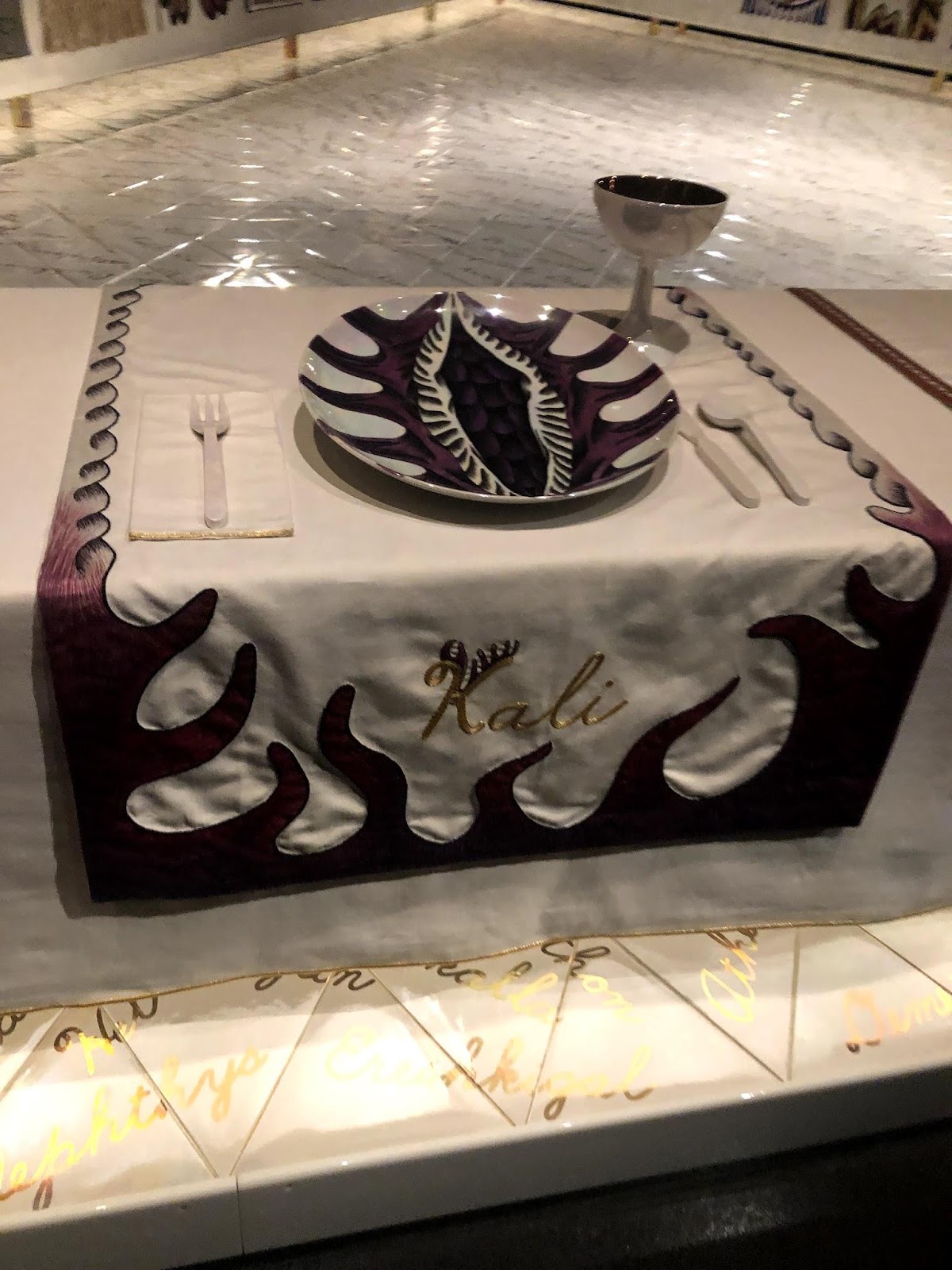Walking into The Dinner Party exhibit by
Judy Chicago I felt the energy radiating off the bright red walls as a red
the words “Welcome to the dinner party”. From a single glass window in front,
I can see just how big the dinner party actually is. There was a short black tunnel entryway
that hung banners above it. These together convey a poem by Judy Chicago. When I walked in
I noticed that the table was triangular and very long on all three sides. Upon it was “plates”
some were ceramic statements while others were eccentric paintings that flew with color.
At first, I was confused by the exhibit and exactly what it was meant to represent, but as
I started looking down and down the tables, it began to become apparent that the works
upon the plates were centered around vaginas
and the vaginal core. (Scroll down for more pictures and examples).
In the last banner recording of Judy Chicago’s poem, she makes a reference
by saying, “and then everywhere was Eden once again”, which I thought was a very
powerful statement considered that Eden is a biblical character not often praised for
eating the forbidden fruit. For her to make this moment as soon as we are about to
witness a huge table full of only women, is momentous for women everywhere.
After reading this banner I knew what Judy Chicago’s exhibit was going to be about,
it was going to be centered around bringing the voices back to all these influential people
who were not given the credit they deserve because they were female. In the late
’60s, when Judy was creating The Dinner Party women, were given very little attention
and seldom mentioned in history books. No one taught women’s history, there were
no books about great women artists, and no women focused studies. What was
most intriguing that not a lot of people notice at first, was the exquisite needlework of the
mats under the tables with the name of great influential women artists that
history refused to acknowledge.
by saying, “and then everywhere was Eden once again”, which I thought was a very
powerful statement considered that Eden is a biblical character not often praised for
eating the forbidden fruit. For her to make this moment as soon as we are about to
witness a huge table full of only women, is momentous for women everywhere.
After reading this banner I knew what Judy Chicago’s exhibit was going to be about,
it was going to be centered around bringing the voices back to all these influential people
who were not given the credit they deserve because they were female. In the late
’60s, when Judy was creating The Dinner Party women, were given very little attention
and seldom mentioned in history books. No one taught women’s history, there were
no books about great women artists, and no women focused studies. What was
most intriguing that not a lot of people notice at first, was the exquisite needlework of the
mats under the tables with the name of great influential women artists that
history refused to acknowledge.
As a huge step for future women, Judy honors the women of the past that did not get the same treatment as their male counterparts. Judy uses the names of 1,038 women in gold cursive writing either embroidered on the placemats or under the table on the ivory floor is gold lettering. The dinner party is something in itself that is very stereotypical of the traditional trophy wife. As I was walking around the galleries and seeing the different interpretations of the butterfly seen through the lens of the vagina, I couldn’t help but think that this was Judy’s way of shutting down every conventional stereotype of the world. Usually, dinner parties are parties that are organized by women for men, but this dinner party is purely for the shock and to make a statement. Firstly, she gave over 1,000 women a platform to stand, almost similar to a monument for them. Second, she uses the most controversial body part of all time as the MEAL on the plates in which they are all different giving these women a personality, a face. Third, she turns her dinner party into a female-only event, which angers men everywhere as a taste of their own medicine. After all, even the last supper was men only. One of the names I did recognize seated at the table was Elizabeth Blackwell which was the first woman to receive a medical degree in the United States, it would be rude not to invite her to the dinner party of course. This is special because it demonstrates a turning point in contemporary art, where it is shocking and beautiful to see unique versions of patterns that display the female anatomy. As a woman, it is empowering to witness history in the making where there are 1,038 different women that have made a significant impact. It is important to have intellectual role models and Judy’s debate offers that for women and girls everywhere. Below, are images of my favorite art at the dinner party





No comments:
Post a Comment